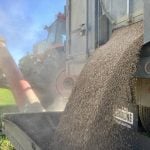Given the possibility of supply shortages of agricultural inputs, including herbicides, I’ve spent more time this winter than most looking into which herbicides have the best fit for my farm. I would much rather purchase now than scramble in the spring, seeking herbicides unavailable or in short supply.
Early planning has also prompted me to put more thought into herbicide rotations and the risks of herbicide resistance in my fields. I searched for products I haven’t used regularly in the past but that control the spectrum of weeds that are usually problematic on my farm.
I discovered that searching for alternative herbicides in different groups for specific weed issues is a big job.
Read Also

Sensing the soil: Root cell research finds ‘stress hormone’
Research into how root cells react to soil stressors could help plants better adapt to changes in their climate.
Let me give you a detailed example. Wild oats are a common weed problem for me, as for most Prairie growers. Opening my 2021 Alberta Crop Protection Guide (Blue Book) to the herbicide selector chart for controlling wild oats in spring wheat revealed 56 herbicide brand names. So, really, with so much choice, how much of a problem could it possibly be to rotate herbicides in wheat to reduce the risk of resistance?
Well, first take out of that list the seven pre-plant, burn-off herbicides which do not control wild oats in-crop. You are now down to 49 herbicides. But that’s still lots to choose from, right?
In terms of brands, yes, but in terms of different modes of action, no!
I compiled a chart that details all 49 wild oat brand names registered for use in spring wheat and organized them by chemical group and active ingredients. To my surprise, I found that of those 49 brands there were only 10 different active ingredients, and those actives were in just four different chemical groups. To make matters worse, one of those actives could only be used in Clearfield wheat, one was only found in a single Group 8 product, and one was in a single Group 3, 8 herbicide. And neither of these last two herbicides can be applied post-emergence.

49 brands; two groups
So in reality, if you are searching for a post-emergence wild oat herbicide for use in all spring wheat varieties, you only have a choice of seven different actives, comprised of three Group 1 and four Group 2 chemistries. That is not a lot of rotational choice!
That list of seven actives expands into 49 herbicides because companies package the same herbicide actives under different brand names. Companies also pre-mix or co-pack a variety of broadleaf actives with the wild oat active under new names.
These are great marketing tools, but they don’t provide more actual wild oat control options or a wild oat herbicide resistance reduction.
Of course, many herbicide products are labelled with multiple group numbers, and “multi-mode control” has become the buzzphrase in herbicide marketing over the last few years. So, if I am buying a Groups 1, 2, 4 herbicide that controls wild oats and other weeds, am I getting multi-mode control?
I posed this question to Chris Willenborg, a weed scientist at the University of Saskatchewan. He told me it depends on how the multi-mode control is effective.
“Effective is the key word,” Willenborg said. “If only one active ingredient is providing effective control of a weed in a herbicide mix, then it is only the group to which that active belongs which is controlling that weed.”
In other words, a herbicide may be labelled with multiple group numbers but if all of the graminicide action is from chemistry in just one group, then you are not getting multi-mode control of grassy weeds with that product.
This problem becomes even more pronounced when you start looking for a herbicide tank-mix partner to control the broadleaf spectrum in your spring wheat. For example, cleavers are a problem on my farm so from the broadleaf selector chart I selected three of the wild oat co-packs which have a broadleaf component effective against cleavers.
All co-packs were labelled as multiple-group herbicides. Brand A was labelled Group 1, 4; Brand B was labelled Group 2, 4; Brand C was labelled Group 2, 4, 6.
In fact, Brand C was formulated with two Group 4 actives. However, after further study, I found that the component controlling cleavers in all three brands was the same Group 2 active. While it certainly appeared from the label that these are different multi-mode herbicides, in truth they all used the same active to control cleavers.

Two actives but same group
This brings me to the third revelation. Herbicide manufacturers are now combining same-group actives under new brand names. While a cursory glance at a product showing two actives gives the impression of multi-mode action, if those two actives are in the same group, what is the real benefit in terms of both efficacy and resistance reduction?
Even more worrisome is that at least a couple of brands now available are pre-packs of reduced rates of same-groups as in existing products. In other words, instead of applying full rates of Brand D or Brand E, you can now purchase Brand F, which is a co-pack of a reduced active rate of D and a reduced active rate of E.
I asked Willenborg about tank mixes with reduced rates of same-group products and he explained they might provide control if there is a synergism resulting from such a tank mix, or from a new adjuvant. But he warned that if herbicide resistance is a concern, a tank mix of same-group products will not significantly delay resistance even if they are from different chemical families within a group.
More information needed
No longer is it enough to know the herbicide group. If they are to make informed decisions about herbicide rotations, farmers or their trusted crop advisors need to be aware of the actual actives, and what weeds are controlled by each active component.
Furthermore, more information is needed about the efficacy of co-packs of same-group actives and the impact of reduced rates of actives in such co-packs. Is there a synergistic effect, and is efficacy improved or not? If not, are we increasing the risk of herbicide resistance by co-packing reduced rates of same-group actives?
The real question is if there is third-party testing being done or underway that can provide real data as to the impact of same-active co-packs and rate reductions. Unfortunately, this information is not in the Blue Book or readily available, even though farmers need it.
I hope this information will make fellow farmers aware of how few herbicide options we actually have and the importance of preventing the loss of use of any herbicide active or group due to resistance. At least, maybe the accompanying chart will assist growers in selecting a wild oat herbicide this spring.
















